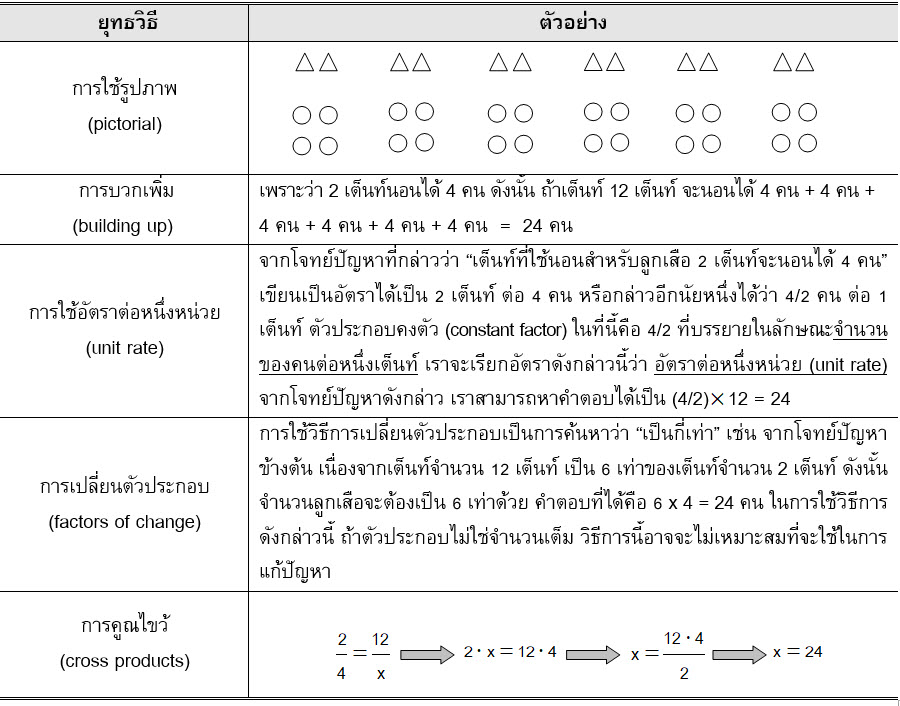การให้เหตุผลเชิงสัดส่วน
Main Article Content
Abstract
Khwan Piasai and Pinyapan Roamchart
รับบทความ: 23 กุมภาพันธ์ 2554; ยอมรับตีพิมพ์: 6 พฤษภาคม 2554
บทคัดย่อ
การให้เหตุผลเชิงสัดส่วนเป็นเรื่องที่สำคัญ เพราะว่าเนื้อหาของหลายๆ วิชาโดยเฉพาะวิชาคณิตศาสตร์และวิทยาศาสตร์ล้วนมีความเชื่อมโยงและใช้แนวคิดของเรื่องดังกล่าว นอกจากนี้การให้เหตุผลเชิงสัดส่วนนี้ยังเชื่อมโยงกับชีวิตประจำวัน รวมทั้งถูกนำไปประยุกต์ใช้กับศาสตร์หลายๆ สาขา เช่น สถาปัตยกรรม ศิลปะ ดนตรี วิศวกรรมศาสตร์ และอีกทั้งบนโลกของเรามีปรากฏการณ์หลายๆ อย่างที่ดำเนินการไปตามกฎของสัดส่วน ดังนั้นการพัฒนาผู้เรียนให้มีความสามารถทางด้านการให้เหตุผลเชิงสัดส่วนนับว่าเป็นสิ่งจำเป็นอย่างยิ่ง องค์ประกอบหนึ่งที่มีอิทธิพลต่อการพัฒนาความสามารถในการให้เหตุผลเชิงสัดส่วน คือ โจทย์ปัญหาเกี่ยวกับการให้เหตุผลเชิงสัดส่วน รวมถึงการเน้นให้ผู้เรียนคิดหายุทธวิธีที่หลากหลายในการแก้โจทย์ปัญหาเกี่ยวกับสัดส่วน เช่น การใช้รูปภาพ การบวกเพิ่ม การใช้อัตราต่อหนึ่งหน่วย การเปลี่ยนตัวประกอบ หรือการคูณไขว้ ทั้งนี้เมื่อเริ่มต้นสอนครูไม่ควรแนะนำวิธีการคูณไขว้แก่นักเรียนก่อน ควรให้นักเรียนได้ค้นพบวิธีดังกล่าวด้วยตนเอง ซึ่งจะทำให้นักเรียนเกิดการเรียนรู้อย่างมีความหมาย
คำสำคัญ: สัดส่วน การให้เหตุผลเชิงสัดส่วน ความสามารถทางด้านการให้เหตุผลเชิงสัดส่วน
Abstract
Proportional reasoning is important because the contents in several subjects are linked and used its concepts, particularly in mathematics and science. In addition, it is linked to way of life and applied with many disciplinary. For example, architecture, art, music, engineering and the world have events concerning the process of proportional rules. The students’ development to have proportional reasoning ability is also essential. One factor that has an influence on the development of proportional reasoning ability is proportional reasoning problem including the teacher focuses on the students’ thinking about various strategies in solving the proportional reasoning problem, for instance, pictorial, building up, unit rate, factors of change or cross products. When the teachers start teaching, they should not suggest student cross products strategy before the students’ discovery by themselves to effect on their meaningful learning occurrence.
Keyword: Proportion, Proportional reasoning, Proportional reasoning ability
Downloads
Article Details

This work is licensed under a Creative Commons Attribution-NonCommercial 4.0 International License.
References
Bezuk, N. (1988). Type of Numeric Ratio on Strategies Used by Preservice and Inservice Elementary Teachers on Proportional Reasoning Word Problems. Proceedings of the Annual Meeting of the North American Chapter of the International Group for the Psychology of Mathematics Education 22(8): 72-78.
Boston, M. D., Smith, M.S., and Hillen, A.F. (2003). Building on Students’ Intuitive Strategies to Make Sense of Cross Multiplication. Mathe-matics Teaching in the Middle School. Reston, VA: NCTM.
Cramer, K. A., and Post, T. R. (1993). Making connection: A case of proportionality. Arithmetic Teacher 60(6): 342-346.
Cramer, K. A., Currier, S. and Post, T. R. (1993). Learning and Teaching Ratio and Proportion: Research Implications. In Research Ideas for the Classroom: Middle Grades Mathematics, edited by Douglas Owens. Reston, Va.: National Council of Teachers of Mathematics and Macmillan.
de la Cruz, J.A. (2008). A look at middle school mathematics teachers' instruction related to proportional reasoning: A cognitively guided perspective. Doctoral Dissertation. Virginia: University of Virginia.
Fleener, M. J., Westbrook, S. L., and Rogers, L. (1993). Why are we doing math in science? : Integrating mathematics and science curricula. Paper presentation at the Annual Meeting of the National Science Teacher Association (NSTA), MO: Kansas City.
Harel, G., and Behr, M. (1995). Teachers' solutions for multiplicative problems. Hiroshima J. Math. Educ. 3: 31-51.
Hoffer, A. R. (1988). Ratios and Proportional Thinking. In Teaching Mathematics in Grades K–8: Research Based Methods. Boston: Allyn and Bacon.
Karplus, R., Pulos, S., and Stage, E. K. (1983). Early adolescents' proportional reasoning on rate Problems. Educ. Studies Math.14: 219-233.
Lamon, S.J. (1993). Ratio and Proportion: Connecting Content and Children’s Thinking. J. Res. Math. Educ. 24(1): 41-46.
Langrall, C. W., and Swafford, J. O. (2000). Three balloons for two dollars: Developing proportional reason- ing. Math. Teach. Middle School 6: 254-261.
Lanius, C. S., and Williams, S. E. (2003). Proportionality: A Unifying Theme for the Middle Grades. Mathematics Teaching in the Middle School Reston, VA: NCTM.
Lesh, R., Post, T. R., and Behr, M. (1988). Proportional reasoning, Number Concepts and Operations in the Middle Grades. Reston, VA: NCTM.
Lo, J. J., and Watanabe, T. (1997). Developing ratio and proportion schemes: A story of a fifth grader. J. Res. Math. Educ. 28(2): 216-236.
National Council of Teachers of Mathematics. (1989). Curriculum and evaluation standards for school mathematics. Reston, VA: NCTM.
National Council of Teachers of Mathematics. (2000). Principles and Standards for School Mathematics. Reston, VA: NCTM.
National Research Council. (2000). Adding it up: Helping children learn mathematics. Washington, DC: National Academies Press.
Noelting, G. (1980). The development of proportional reasoning and the ratio concept: Part1 Differentiation of stages. Educ. Studies Math. 11: 217-253.
Parker, M. (1999). Building on 'Building-up': Proportional reasoning activities for future teachers. Math. Teachi. Middle School 4(5): 286-289.
Ruchti, W. P. (2005). Middle school students' use of pictorial models and discourse in the develop-ment and assessment of proportional reason-ing. Doctoral Dissertation. Idaho: University of Idaho.
Singh, P. (1998). Understanding the Concepts of Proport- ion and Ratio among Students in Malaysia. Doctoral Dissertation. Florida: The Florida State University.
Tourniaire, F. (1986). Proportion in elementary school. Educ. Studies Math. 17(4): 401-412.
Tourniaire, F., and Pulos, S. (1985). Proportional reason-ing: A review of the literature. Educ. Studies Math. 16: 181-204.
